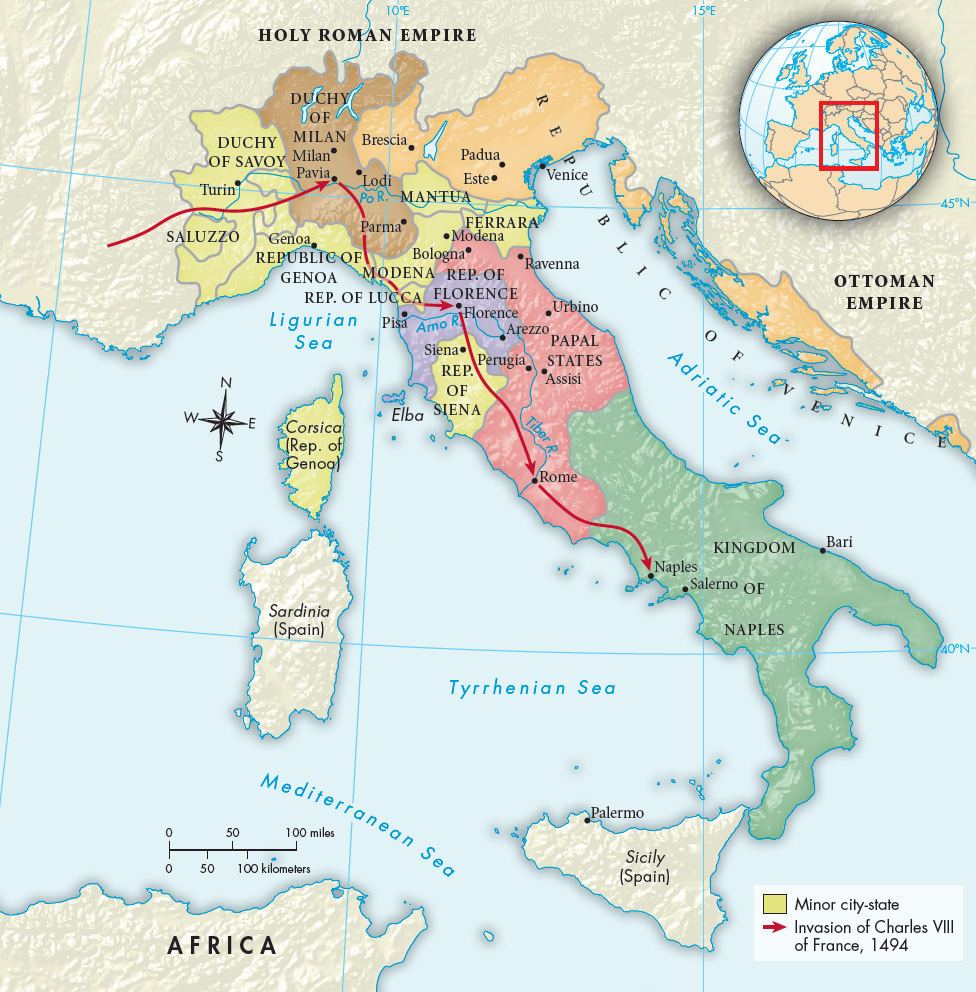A History of Western Society: Printed Page 360
A History of Western Society, Value Edition: Printed Page 369
City-States and the Balance of Power
Renaissance Italians had a passionate attachment to their individual city-states: political loyalty and feeling centered on the city. This intensity of local feeling perpetuated the dozens of small states and hindered the development of one unified state.

In the fifteenth century five powers dominated the Italian peninsula: Venice, Milan, Florence, the Papal States, and the kingdom of Naples (Map 12.1). The major Italian powers controlled the smaller city-states, such as Siena, Mantua, Ferrara, and Modena, and competed furiously among themselves for territory. While the states of northern Europe were moving toward centralization and consolidation, the world of Italian politics resembled a jungle where the powerful dominated the weak. Venice, with its enormous trade empire, ranked as an international power. Though Venice was a republic in name, an oligarchy of merchant-aristocrats actually ran the city. Milan was also called a republic, but the condottieri-turned-signori of the Sforza (SFORT-sah) family ruled harshly and dominated Milan and several smaller cities in the north from 1447 to 1535. Likewise, in Florence the form of government was republican, with authority vested in several councils of state, but the city was effectively ruled by the great Medici (MEH-duh-chee) banking family for three centuries, beginning in 1434. Though not public officials, Cosimo, his son Piero, and his grandson Lorenzo ruled from behind the scenes from 1434 to 1492. The Medici were then in and out of power for several decades, and in 1569 Florence became no longer a republic, but the hereditary Grand Duchy of Tuscany, with the Medici as the Grand Dukes until 1737. The Medici family produced three popes, and most other Renaissance popes were also members of powerful Italian families, selected for their political skills, not their piety. Along with the Italians was one Spaniard, Pope Alexander VI (pontificate 1492–1503), who was the most ruthless; aided militarily and politically by his illegitimate son Cesare Borgia, he reasserted papal authority in the papal lands. South of the Papal States, the kingdom of Naples was under the control of the king of Aragon.
In one significant respect, however, the Italian city-states anticipated future relations among competing European states after 1500. Whenever one Italian state appeared to gain a predominant position within the peninsula, other states combined against it to establish a balance of power. In the formation of these alliances, Renaissance Italians invented the machinery of modern diplomacy: permanent embassies with resident ambassadors in capitals where political relations and commercial ties needed continual monitoring. The resident ambassador was one of the great political achievements of the Italian Renaissance.
At the end of the fifteenth century Venice, Florence, Milan, and the papacy possessed great wealth and represented high cultural achievement. Wealthy and divided, however, they were also an inviting target for invasion. When Florence and Naples entered into an agreement to acquire Milanese territories, Milan called on France for support, and the French king Charles VIII (r. 1483–1498) invaded Italy in 1494.
Prior to this invasion, the Dominican friar Girolamo Savonarola (1452–1498) had preached in Florence a number of fiery sermons attended by large crowds predicting that God would punish Italy for its moral vice and corrupt leadership. Florentines interpreted the French invasion as the fulfillment of this prophecy and expelled the Medici dynasty. Savonarola became the political and religious leader of a new Florentine republic and promised Florentines even greater glory in the future if they would reform their ways. (See “Primary Source 12.1: A Sermon of Savonarola.”) He reorganized the government; convinced it to pass laws against same-sex relations, adultery, and drunkenness; and organized groups of young men to patrol the streets looking for immoral dress and behavior. He held religious processions and what became known as “bonfires of the vanities,” huge fires on the main square of Florence in which fancy clothing, cosmetics, pagan books, musical instruments, paintings, and poetry that celebrated human beauty were gathered together and burned.
For a time Savonarola was wildly popular, but eventually people tired of his moral denunciations, and he was excommunicated by the pope, tortured, and burned at the very spot where he had overseen the bonfires. The Medici returned as the rulers of Florence.
The French invasion inaugurated a new period in Italian and European power politics. Italy became the focus of international ambitions and the battleground of foreign armies, particularly those of the Holy Roman Empire and France in a series of conflicts called the Habsburg-Valois wars (named for the German and French dynasties). The Italian cities suffered severely from continual warfare, especially in the frightful sack of Rome in 1527 by imperial forces under the emperor Charles V. Thus the failure of the city-states to consolidate, or at least to establish a common foreign policy, led to centuries of subjection by outside invaders. Italy was not to achieve unification until 1870.